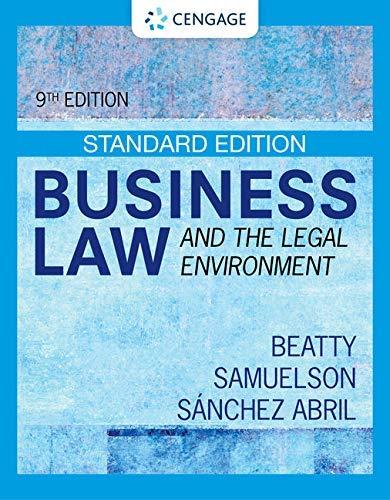Question
Please give a long paragraph answer for the following questions based the the three current business issues provided. Please refer to these issues in terms
Please give a long paragraph answer for the following questions based the the three current business issues provided. Please refer to these issues in terms of the relevant Canadian legal issues. Iclude quotes as well please.
Questions:
What are the relevant legal issues?
What does the law tell us about these issues?
What actions were taken?
How was the law applied?
Did they overlook any legal issues? If they did, explain. If they did not, explain.
Provide recommendations to improve the legal aspects of management of this situation.
Business issues:
Supply chain disruptions: This has been a significant issue due to the COVID-19 pandemic, natural disasters, geopolitical tensions, and labor shortages. Companies are grappling with delays, increased costs (inflation), and inventory management challenges. Global trade tensions, export controls, and economic sanctions imposed by governments can impact cross-border transactions, supply chain operations, and business relationships. Compliance with trade regulations and navigating trade disputes are critical for companies engaged in international commerce.
Digital transformation, remote work and workforce management: Accelerated by the pandemic, businesses are navigating the complexities of digitalization, including cloud migration, cybersecurity, data privacy, and the integration of emerging technologies like AI and blockchain. As remote work becomes more prevalent, companies need clear policies and procedures to address legal obligations related to employment law, health and safety regulations, and remote work agreements. This includes addressing issues such as employee classification (e.g., independent contractors vs. employees), overtime pay, ergonomic standards for remote workstations, and liability for workplace injuries occurring at home. Organizations are reimagining the future of work, balancing remote and hybrid models, addressing employee well-being, maintaining productivity, and fostering company culture in a distributed environment.
Sustainability, health and safety concerns, and ESG (Environmental, Social, and Governance) initiatives: There's growing pressure from consumers, investors, and regulators for businesses to adopt sustainable practices, reduce carbon footprints, promote diversity and inclusion, and ensure ethical supply chains (for example using paper bags instead of plastic bags). Workplace health and safety regulations, including those related to COVID-19 precautions, occupational hazards, and employee welfare, are important legal considerations for businesses. Non-compliance can result in regulatory penalties, lawsuits, and reputational damage. Amid ongoing public health challenges, businesses are prioritizing health and safety protocols for employees, customers, and supply chain partners, while navigating evolving regulations and pandemic-related uncertainties.
References:
Business Law in Canada (12th ed., 2020) by Richard Yates, Teresa Bereznicki-Korol, Trevor Clarke, and Dean Palmer* (Can also use the 11th edition (2017).)
Please reference sources.
Step by Step Solution
There are 3 Steps involved in it
Step: 1

Get Instant Access to Expert-Tailored Solutions
See step-by-step solutions with expert insights and AI powered tools for academic success
Step: 2

Step: 3

Ace Your Homework with AI
Get the answers you need in no time with our AI-driven, step-by-step assistance
Get Started


